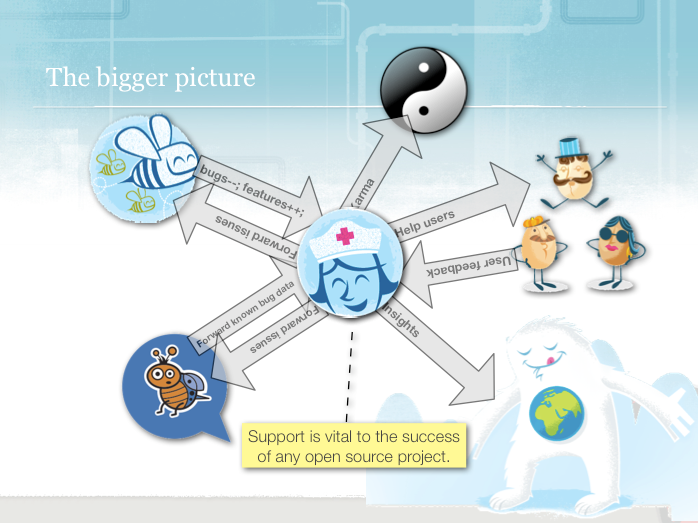A critical piece in having a community-powered project run successfully is that all participants understand the bigger picture. In the case of SUMO, there are actually two pictures, and with part two of this blog series I will try to explain both of them.
Picture 1: The truly big picture
Looking at how SUMO relates to the rest of the Mozilla project, this could be called the macro version of the bigger picture. This picture was made for a presentation I gave at FOSSCoach (OSCON 2008, Portland, Oregon) and is intentionally a little busy, and friendly. :) It does highlight some very important things, though:
- We’re not just helping our users solve their problems with Firefox so they can keep using their favorite browser; we’re here to listen to our users as well. Past readers of this blog series know that part 1 covered exactly this.
- The data we can gather by looking at stats for the Knowledge Base articles combined with incoming support requests in the Support Forum, Live Chat, letters and e-mails all help painting a better picture of what our top issues in Firefox are.
- The support and QA teams can work together and combine their findings from channels targeting different types of users and reach a shared understanding of which bugs we should be working on first.
- Knowing which features and bugs to focus on will be invaluable information for the development team. It will lead to a better product, and a better understanding of what our users want.
That’s the most important way support interacts with other parts of the Mozilla project, but far from the only ones. There are other aspects of the bigger picture, for example that the QA and development teams usually have information about known issues prior to releases gathered from the beta testers. This knowledge should be shared with the SUMO team prior to releases, so we can, among other things, prepare for a better support experience for our users.
In some cases QA might be working hard to track the cause of a known issue down; if the SUMO community is aware of that bug, they can confirm this with the users reporting it and get a unique chance to do some direct QA testing with a user. People from the QA team could even be logged on to the Live Chat component using a Jabber client of their choice, and the SUMO team could invite a QA tester to a chat session whenever a good chance to solve a known issue comes up.
Picture 2: The “support funnel”
This could also be called the micro version of the bigger picture, or the internal picture. As many people are already aware, SUMO is a support project consisting of three major components: the Knowledge Base, the Support Forum, and Live Chat. Many contributors provide support in more than one component. For example, Bo regularly helps out in the Support Forum, but occasionally he also writes Knowledge Base articles for new solutions to Firefox issues. Another example is myles7897, who regularly helps out with Live Chat. Just as Bo, he sometimes writes or edits Knowledge Base articles too.
However, not everyone helping out with SUMO will be aware of how the three components relate to each other, or how the site should work for users. The “support funnel” is a way to describe this:
- The Knowledge Base should contain the solutions to our most common problems. Users should start by searching for their problem here. Ideally the vast majority of our users find the solution to their problem here; it’s critical both for performance reasons and for quality of support. Using the funnel metaphor, the user would go straight through the funnel without hitting the sides.
- If they can’t find the solution to their problem in the Knowledge Base, the forum should show if others have already reported the problem. (We’re working on making this step simpler — more on that later in this series.)
- If neither the Knowledge Base nor the forum contains the answer, the forum or Live Chat should be available to the user. These two components should be viewed as fallbacks when the Knowledge Base fails to solve the user’s problem. Which of the two fallbacks is best for the user depends on the situation. The forum has the benefit that the posted question is public and can be read by many people, thus increasing the chance of getting answered, while Live Chat offers a direct communication with a Firefox expert, if the user is willing to wait for it.
- Frequent or serious issues solved in the forum or Live Chat should be documented in the Knowledge Base, to ensure that the support quality and performance remain consistently high, and to allow us to get better data on which issues are the most commonly reported.
It’s important that everyone contributing to SUMO has a clear understanding of how the Knowledge Base, the Support Forum, and Live Chat interact and relate to each other. That way we can ensure that the “support funnel” works.
Finally, the insights we will gain from this collaboration will be shared with the rest of the Mozilla project as well. A better knowledge of what our users want in our product would be incredibly powerful information to the marketing team, which SUMO is proudly a part of. Similarly, getting better information about what security issues are most commonly reported would likely be valuable for the security team. Et cetera, et cetera; I think I made my point. :)
In other words, support is vital to the success of Mozilla, or any open source project for that matter.


Bo wrote on
wrote on